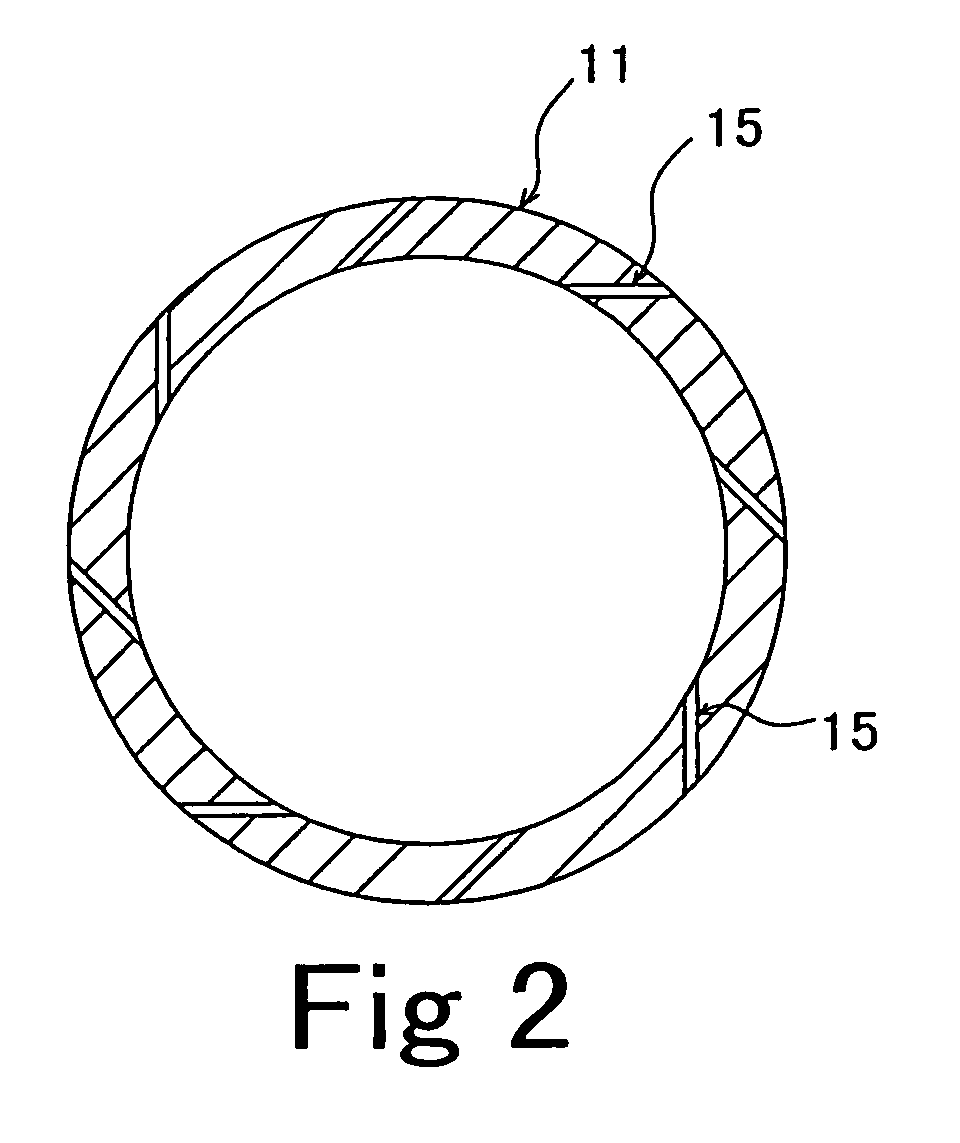[0019]The present invention provides a waste gas treatment system having a burner part and a
combustion chamber provided at the downstream side of the burner part, wherein combustion flames are formed from the burner part toward the
combustion chamber. A waste gas is introduced into the combustion flames, thereby oxidatively decomposing the waste gas. In the waste gas treatment system, the combustion chamber is formed from an inner wall made of a
fiber-reinforced
ceramic material. Therefore, the wear of the inner wall due to heat and
corrosion is minimized, and thermal stress
cracking is also reduced. Consequently, the lifetime of the system increases, and the cost of equipment and the
availability factor can be improved. In addition, because the inner wall exhibits no
catalytic effect, the formation of thermal
NOx is suppressed, and it is possible to achieve
environmental preservation and to simplify the treatment equipment. In addition, because the space between the inner wall and the outer vessel is maintained under a purge gas
atmosphere of higher pressure than the pressure in the combustion chamber, it is possible to prevent hazardous gases in the combustion chamber from leaking to the outside.
[0020]In addition, there is provided a waste gas treatment system wherein a burner part has a cylindrical member which is closed at the top thereof and has an opening at the bottom thereof. The cylindrical member has a waste gas inlet in the top thereof and an air
nozzle at a predetermined position on the side wall thereof. The cylindrical member further has an auxiliary burning gas
nozzle in the side wall in the vicinity of the opening. A waste gas introduced from the waste gas inlet and air blown off from the air nozzle are mixed together, and an auxiliary burning gas blown off from the auxiliary burning gas nozzle is ignited to form combustion flames downward below the opening. In addition, a cooling means is provided to cool an auxiliary burning gas inlet part for introducing a
fuel gas into the auxiliary burning gas nozzle. Accordingly, even when the auxiliary burning gas inlet part is heated by flames, the rise in temperature is suppressed below the
ignition point of the auxiliary burning gas. Therefore, there is no danger that the auxiliary burning gas may explode.
[0021]In addition, there is provided a waste gas treatment system that is provided with a dust removing means for removing dust from the inner wall of the burner part and / or the inner wall of the combustion chamber or for preventing adhesion of dust thereto, thereby allowing the waste gas treatment system to be operated for a long period of time.
[0022]In addition, there is provided a dust remover for removing dust from the inner wall of
piping through which a gas containing a large amount of dust flows. The dust remover includes a scraping mechanism placed in the
piping. The scraping mechanism has rod-shaped scraping member secured to a main shaft to extend in the longitudinal direction of the piping. The dust remover further includes a support mechanism for supporting the main shaft of the scraping mechanism so that the scraping member moves in the inner
peripheral direction in contact with the inner surface of the piping or with a slight gap therebetween, and a driving mechanism for continuously or periodically oscillating or rotating the scraping mechanism about the main shaft. Thus, a cleaning gas is supplied from the outside of the piping through the hollow portions of the main shaft and the scraping member and blown off from the distal end of the scraping member or from a multiplicity of holes or slits in the surface thereof. Consequently, it is possible to remove dust from an area in the piping that cannot be reached by the scraping member. In addition, it becomes possible to remove dust attached to the scraping mechanism itself.
[0025]In addition, there is provided a waste gas treatment system having a burner part, a combustion chamber provided at the downstream side of the burner part, and a combustion
gas cooling section provided at the downstream side of the combustion chamber. The burner part, the combustion chamber and the combustion
gas cooling section are provided integrally. The burner part is provided with a waste gas inlet for introducing a waste gas and an air nozzle for injecting air to generate a swirling flow. The combustion
gas cooling section is provided with a liquid
spray nozzle for spraying a liquid for cooling the waste gas flowing in from the combustion chamber and for capturing dust contained in the waste gas, an
exhaust pipe for discharging the waste gas, and a drain
pipe for draining the liquid sprayed from the liquid
spray nozzle. With the waste gas treatment system thus arranged, the waste gas can be decomposition-treated, and dust, HCl and HF in the waste gas introduced from the waste gas inlet can be efficiently captured and absorbed in the liquid sprayed from the
spray nozzle.
 Login to View More
Login to View More  Login to View More
Login to View More 


